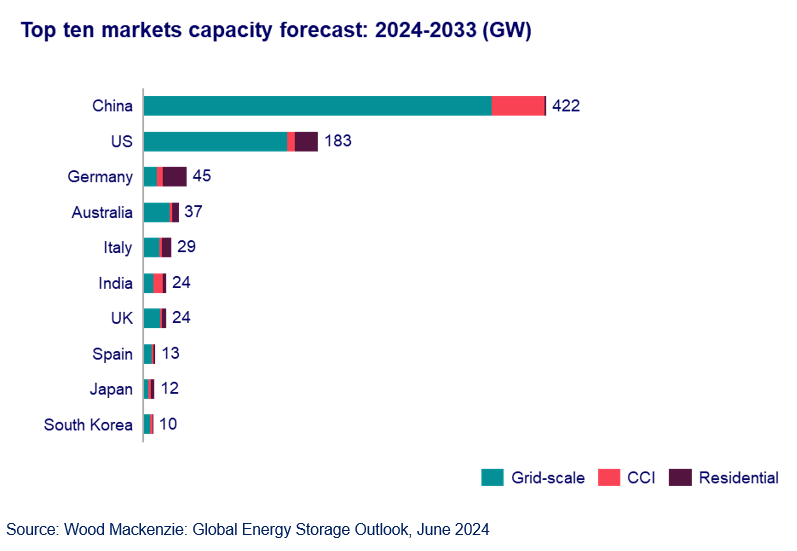Wood Mackenzie forecasts 4.7 TW of solar capacity to be built between 2024 and 2033, with China accounting for about 50% of the growth.
In less than a decade, data and analytics firm Wood Mackenzie forecasts that the world will multiply its total renewable energy capacity.
From 2024 to 2033, the firm forecasts that 4.7 TW of DC solar capacity will be installed globally. China is expected to contribute 50% of the total.
Solar and wind together are expected to add 5.4 TW through this period, increasing the global total to 8 TW. Energy storage capacity is expected to grow by more than 600%, with 1 TW expected to come online over the period.
“Global demand for renewables has reached unprecedented levels, driven by country-level policy targets, technology innovation, and concerns over energy security. Integrated power technology solutions will continue to evolve, evidenced by a significant increase in storage-paired capacity growth, despite inflation, grid constraints and permitting challenges,” said Luke Lewandowski, vice president, global renewables research at Wood Mackenzie.
The firm forecasts that 500 GW of new solar and wind capacity installed in 2023, and average 560 GW annually over the 10-year outlook. Solar is expected to account for 59% of global capacity added over the period.

In the first quarter, U.S. developers installed more solar in the first quarter of 2024 than in all of 2019. Installations in China were up 36% year-on-year, and new capacity in India through Q1 were equivalent to 85% total capacity installed in 2023. However, Europe’s distributed solar boom has started to weaken, with first quarter residential installations contracting more than 30% in Germany and over 50% in the Netherlands as retail rates come down.
“Ultra-low module prices intensified the rate of solar deployments last year in Europe and China and will continue to do so in the near-term. But grid constraints and a return to lower power prices and subsequently lower capture rates will impact markets and other regions,” said Juan Monge, principal analyst, distributed solar PV at Wood Mackenzie.
Monge added that maximizing solar capacity in the next 10 years will depend on additional technology developments from expanding grid infrastructure to incentivizing flexibility solutions, transportation and heating electrification.
Drastic drops in solar module prices and tight interconnection deadlines have triggered 150% annual growth for PV installations globally, said Wood Mackenzie. The firm expects this growth curve to continue until 2026, when there may be a two-year slowdown due to an expected pause in development activity before the next round of planned procurement drives higher deployment.
Meanwhile the global energy storage market is on track to reach 159 GW/358 GWh by the of 2024. Looking ahead, 926 GW/2789 GWh is expected to be added between 2024 and 2033, marking a 636% increase.
“The growth represents just the start for a multi-TW market as policy support in terms of tax exemption and capacity and hybrid auctions accelerate storage buildout across all regions,” said Anna Darmani, principal analyst, energy storage, at Wood Mackenzie.
This content is protected by copyright and may not be reused. If you want to cooperate with us and would like to reuse some of our content, please contact: editors@pv-magazine.com.



















